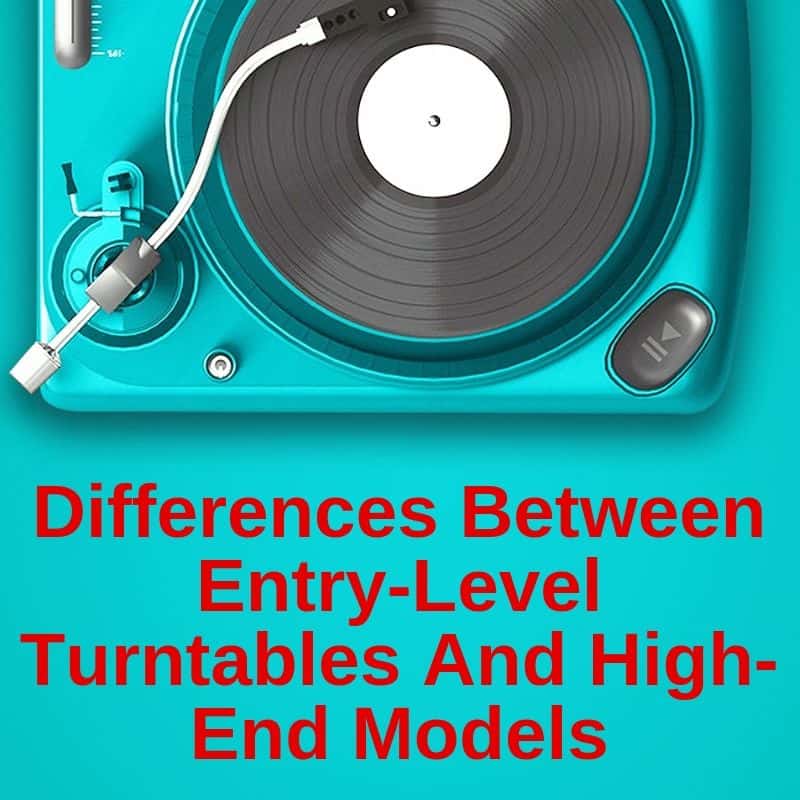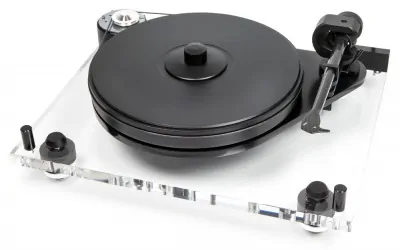
A high-end turntable can cost anywhere from 3 to 5 times more than an entry-level one, which makes you wonder if the differences are significant enough to warrant the extra investment.
There are a lot of differences, but do they actually result in a large enough improvement in performance to justify the higher cost?
We decided to investigate what the differences are exactly and how they affect sound quality.
Keep reading to learn what factors make a turntable good and differentiate high end models from entry level ones.
Contents
Entry Level Vs High End Record Players
The following are the biggest differences between high end record players and entry level models. It would also be a good idea to read our article Turntable Vs Record Player to learn about the difference between those two.
Weight
When it comes to turntables the general rule is: the heavier the better. That’s because the heavier the turntable the better it can absorb vibration. You should still take steps to isolate your turntable from vibration, but the player itself can handle whatever leftover vibration there is.

High-end tables tend to be heavy exactly for that reason. They provide better stability and less outside (engine) noise, while entry-level ones tend to be made with lighter material, which results in more vibration and other outside interference to sound quality.
An easy way to test the level of interference is to go to a trustworthy store and asking them to play the same vinyl record on multiple record players. More expensive and heavier players will always produce a cleaner, better sound.
The differences in size, weight and overall build are generally pretty substantial, but we decided to go even deeper and analyze the differences in every part of the turntable, to help you make an informed decision on which price level suits you best.
Platter
Generally, entry-level turntables have a platter made of steel with a felt mat on top to reduce vibrations. This combo provides a basic, decent vinyl sound. High-end players have a platter made of MDF (medium-density fiberboard) wood with a layer of vinyl on top.
They also come with a clamp device that presses the vinyl record down on the platter. This all results in a cleaner sound that is mostly absent of outside interference.
Motor
Entry-level turntables use the simplest type of motor, which works fine but affects sound quality. These motors also tend to wear down more quickly. Once that happens, your record player sounds distorted.
On the other hand, high-end players use motors with suspension that have a heavy, metal damping ring machine around them. This makes the motor much more resistant to vibration and therefore quieter.
Belt
On entry-level turntables you are going to find a normal subplatter underneath the main one, but high-end players feature a belt running on the outer perimeter of the platter. This allows the motor to be further away, reducing interference from the motor on the sound output.
Cheaper belts also tend to wear out faster, which can cause them to break or to slip. A slipped belt is a common cause of a record player playing too fast.
Tonearm
High-end tonearms really stand, because they are made from carbon fiber and have a much more precise bearing (a large bearing ring is used to reduce resonance). The tonearm has 4 points: 2 points on the horizontal and 2 on the vertical, resulting in a much more precise sound.
Electronic Speed Controller
If you have a normal turntable and you want to change from 33 rpm to 45 rpm, you have to remove the main platter and use the provided tool to manually change the belt.
On high-end turntables, that is done electronically with a controller. Not only does this make changing speeds and record types much easier, it also helps the motor run at a more precise and consistent speed.
Who Should Buy An Entry-Level Turntable?
An entry-level player will go a long way for people who are just starting to get into vinyl. It plays records and will not cost you too much. A good one can be had for a few hundred dollars.
If you don’t have a lot of capital to invest and you are mainly into casual vinyl listening, you really don’t need more than a good entry-level player provides. Plus, you can always upgrade down the road, if you find you have outgrown your entry-level model.
If you’ve decided that an entry-level player is right for you, we have reviewed a number of them on this site.
The one we recommend the most is the Project Debut Carbon DC. Our review of that player is a good place to start. We also do a direct comparison of the Pro-ject Debut Carbon vs vintage record players.
An old-school classic newbie record layer in the Marantz TT42P. It is no longer available, but you can still view our review of the Marantz TT42P. In it, we compare that model to the still-available Denon DP300F. It is very similar, which makes sense considering both brands are owned by the same company.
Who Should Buy A High-End Turntable?
If you are a vinyl aficionado and you have the money to invest, a high-end turntable is definitely your best choice. It will give a quieter, cleaner and more precise sound. In short, it will make your record collection sound its absolute best.
Real audiophiles also know that an investment in a good turntable is also in investment in vinyl safety. Higher quality players come with higher quality needles that will not scratch your records. Your vinyl collection will last longer and need less maintenance, assuming you use your turntable correctly.
DJs also need higher quality models, whether they use them only to spin, whether they do a lot of scratching or whether they use their turntable to sample.
But when you pay that much money for a record player, you obviously need to take better care of it. Keep it in top working condition and if you ever need to ship it anywhere, read how to ship a turntable to learn how to package it correctly to ensure it arrives safely.
Here is a list of our favorite high-end turntables. You will be sure to find one that fits your needs there.
Are Expensive Turntables Worth It?
If you are a serious vinyl record collector and you have the money to spend, then an expensive turntable can be worth it. But for most casual vinyl record listeners, a solid mid-range player makes much more sense.
This is the price range where you find the best values and much more expensive players may sound better, but not so much that most people would be able to notice.
We recd one of the box turn tables and it worked fine. We went to play and no sound from speakers some sound from needle but no sound. What should we do. ?
Can’t agree with quite a few of your points, rather oversimplified. MDF platter on a high end deck? No mention of idler or DD? That’s just for starters.
There are a number of mis-statements in this article. Weight may have some correlation with quality in a turntable in a general way, but it’s absurd to make a blanket statement like “the heavier the better.” If that were true, we’d be buying turntables by the pound.
This statement “High-end players have a platter made of MDF (medium-density fiberboard) wood with a layer of vinyl on top.” is simply wrong. Some high-end and some low-end turntables have plinths made of MDF (not platters–I think you’ve confused the two). Both plinths and platters are made of a wide range of different materials, often reflecting different design philosophies and, perhaps more commonly, different cost calculations. For example, glass is a common material for making platters on high-end turntables.
You may want to think a bit more, A slipping belt will run slower not faster and have higher wow and flutter.
A lot of platters are cast Alloy, not steel.
You should do a little more research and rewrite this.
it all seems so annoying lol like i feel like as long as your speakers are good it shouldn’t matter. also vinyl does not have better sound than the quality of apple music, stop lying to yourselves
Nonsense. Turntables DO NOT have “sound quality”. Every properly designed turntable “sounds” exactly the same. It’s a simple mechanical device that has nothing to do with “sound quality”.